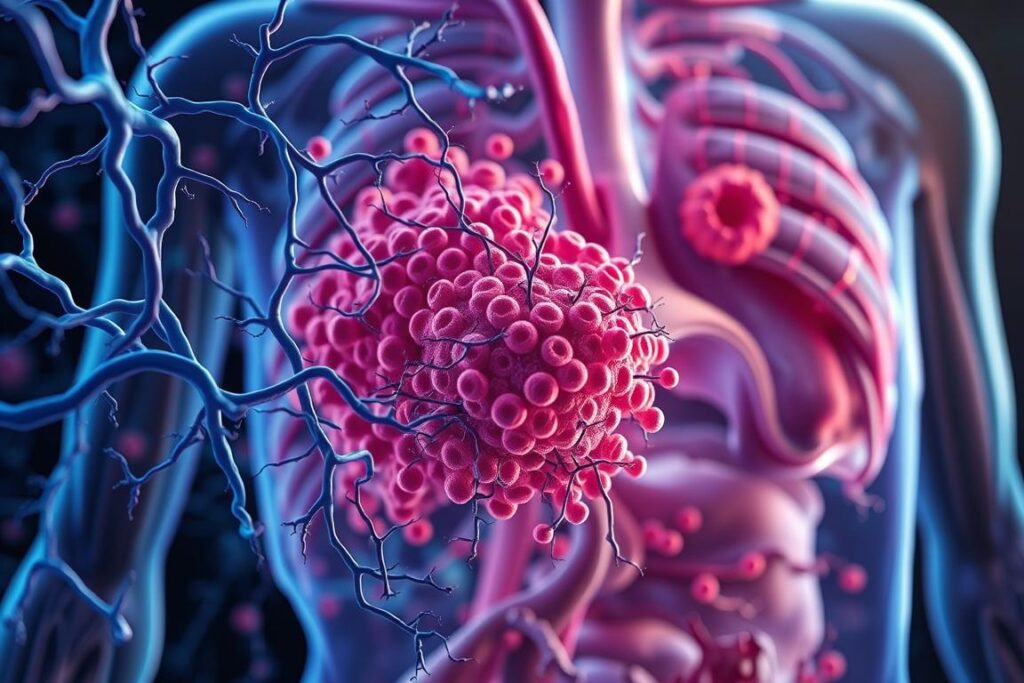Neuroendocrine stress regulation: functions and effects explained
Chronic stress is a widespread phenomenon in modern society that has far-reaching effects on health. Studies show that a significant proportion of the population suffers from the consequences of prolonged stress.
The body has complex mechanisms for reacting to stress. Neuroendocrine stress regulation plays a central role here by enabling adaptation to various stressful situations and coordinating vital functions.
In the context of today’s living conditions, we are facing new challenges for our stress response systems. Understanding the function of these systems is crucial for developing strategies for coping with stress.
Understanding the body’s stress system
Understanding stress and its effects on the body is of great importance. Our body is exposed to different types of stress on a daily basis, which can be described as stress.
Definition of stress and stressors
Stress is defined as a state in which the organism is confronted with increased demands that require an adaptive response. Stressors are the factors that trigger this reaction and can be of a physical, psychological or social nature.
- Physical stressors include injury or cold.
- Psychological stressors can arise from exam situations or conflicts.
- Social stressors often result from isolation or excessive demands.
Eustress vs. distress: the difference
Eustress describes positive stress that promotes well-being and contributes to growth and development. In contrast, distress describes negative stress that impairs well-being and can lead to health problems.
Biological significance of the stress response
The stress response has evolved as a survival mechanism that enables the rapid mobilization of energy reserves and increased alertness in dangerous situations. The organism’s ability to adapt to changing environmental conditions and maintain homeostasis in challenging situations are crucial for health.
By understanding these mechanisms, we can better understand how stress affects our physical and mental well-being and the importance of healthy adaptation to stressful situations.
Basics of neuroendocrine stress regulation
Neuroendocrine stress regulation is a complex system based on different axes. When the body is exposed to stress, these axes are activated to enable an appropriate stress response.
The hypothalamic-pituitary-adrenal axis
The hypothalamic-pituitary-adrenal axis (HPA axis) plays a central role in stress regulation. Stress stimuli stimulate the release of corticotropin-releasing hormone (CRH) from the hypothalamus, which in turn leads to the release of ACTH from the pituitary gland and ultimately cortisol from the adrenal cortex.
Cortisol is the most important stress hormone in humans and has many effects on the body, including the regulation of metabolism and the suppression of the immune system.
The sympathetic-adrenal medullary axis
The sympathetic-adrenal axis mediates the rapid „fight-or-flight“ response by activating the sympathetic nervous system. This leads to the release of adrenaline and noradrenaline from the adrenal medulla, which helps prepare the body for a stress response.
Neurotrophin neuropeptide axis
The neurotrophin-neuropeptide axis comprises various neuropeptides and neurotrophins that are released during stress. These molecules, such as substance P and BDNF, influence inflammatory processes, pain perception and neuronal plasticity and thus contribute to coping with stress.
The three axes of neuroendocrine stress regulation work together to ensure a coordinated stress response and maintain the organism’s homeostasis. The activation of these axes is crucial for the function of the stress system and adaptation to stressful situations.
Hormones as stress mediators
Neuroendocrine stress regulation involves a complex interaction of different hormones that are responsible for the body’s stress response. These hormones enable the body to react to various stressors and adapt to stressful situations.
Cortisol: the primary stress hormone
Cortisol is an important hormone that is produced in the adrenal cortex. It plays a central role in the mobilization of energy reserves through gluconeogenesis and the regulation of the immune system during stressful situations. During acute stress, the cortisol level in the blood rises, which is adaptive in the short term. However, a chronic increase can lead to health problems such as immunosuppression, muscle breakdown and cognitive impairment.
Adrenaline and noradrenaline: the fight-or-flight hormones
Adrenaline and noradrenaline are released by the adrenal medulla during stress and mediate the classic „fight or flight“ response. They increase the heart rate, dilate the bronchial tubes, increase blood flow to the skeletal muscles and mobilize glucose. The release of adrenaline can increase by up to 2500% of the resting level during extreme stress, while noradrenaline can increase by up to 800%.
CRH and ACTH: the control hormones
CRH (corticotropin-releasing hormone) and ACTH (adrenocorticotropic hormone) act as superordinate control hormones of the stress axis. CRH is released by the hypothalamus and stimulates the release of ACTH from the pituitary gland, which in turn stimulates cortisol production in the adrenal cortex. These hormones play a decisive role in the regulation of the stress response.
Acute vs. chronic stress reaction
The body’s stress response can be divided into two categories: acute and chronic. These two forms of stress have different effects on the body and its functions.
Fight-or-flight reaction during acute stress
The acute stress response, also known as the „fight-or-flight“ response, is an evolutionarily conserved response to immediate threats. It is characterized by the rapid activation of the sympathetic nervous system and the release of stress hormones such as adrenaline and noradrenaline.
- Rapid redistribution of blood flow to the skeletal muscles and brain
- Increase in heart rate and blood pressure
- Changes in the metabolism for rapid energy supply
Long-term consequences of chronic stress
Chronic stress occurs when stressors persist over a long period of time or the stress response is not adequately down-regulated. This leads to a permanent activation of the stress axes and can lead to a variety of long-term consequences.
- Metabolic changes such as insulin resistance
- Cardiovascular problems and immunosuppression
- Cognitive impairment and increased risk of mental illnesses such as depression and anxiety disorders
In a stressful situation, the body cannot remain in the acute stress response for long without negative consequences. Prolonged stress can lead to changes in metabolism and other bodily functions.
Brain and stress processing
Stress processing primarily takes place in the brain and influences our reactions. The brain is the central organ for processing and evaluating stressors, with various regions of the brain involved in regulating the stress response and forming a complex network.
The role of the limbic system
The limbic system, in particular the amygdala (amygdala) and the hippocampus, is significantly involved in the emotional evaluation of stressors. It can initiate or modulate the activation of the stress axes by giving meaning to the information received via sensory cortical areas of the brain.
- The amygdala mediates an active response to challenges.
- The hippocampus is more responsible for a passive response.
- The limbic system plays a central role in emotional processing.
Prefrontal cortex: control of the stress response
The prefrontal cortex controls our behavior at the highest level and guides us through a social, ethical and emotionally controlled context. It assumes an important control function in stress regulation by dampening the emotional reactions of the limbic system.
Neuroplasticity and stress adaptation
The neuroplasticity of the brain enables adaptation processes to repeated stress. This ability to adapt varies from person to person and is influenced by genetic factors, early life experiences and current environmental conditions.
Chronic stress can lead to structural and functional changes in the brain, such as a reduction in the volume of the hippocampus and an impairment of prefrontal control functions. This underlines the importance of the brain in stress processing and regulation.
Neuroendocrine stress regulation and the immune system
Stress and the immune response are closely linked via neuroendocrine mechanisms. The stress reaction and the immune response are closely linked, with the release of stress hormones such as cortisol and adrenaline playing an important role.

Psychoneuroimmunological connections
Psychoneuroimmunology investigates the complex interactions between the nervous system, the endocrine system and the immune system. Stress is identified as an important modulator of immune function.
Acute stress can lead to a short-term activation of certain immune functions, while chronic stress often causes a dysregulation of the immune system with increased inflammatory activity and a simultaneous weakening of the adaptive immune defense.
Inflammatory processes and stress response
Stress hormones such as cortisol and adrenaline bind to specific receptors on immune cells and influence their activity, migration and cytokine production. This has a direct effect on inflammatory processes in the body.
- Chronic stress can lead to persistent activation of the innate immune system.
- This results in increased production of pro-inflammatory cytokines such as IL-1, IL-6 and TNF-α.
Fatigue as a result of immunological dysregulation
Fatigue occurs in various diseases that are associated with immunological dysregulation. It can be understood as part of an evolutionarily conserved mechanism that forces the organism to take it easy and regenerate in the event of infections or other stresses.
The persistent activation of the immune system and the resulting production of pro-inflammatory cytokines can trigger behavioral changes such as fatigue.
Stress and mental illness
The link between stress and mental illness is complex and multi-layered. Stress can influence the development and course of various mental illnesses.
Depression as a stress disorder
Depression is increasingly understood as a stress disorder in which dysregulation of the neuroendocrine stress axes, in particular the HPA axis, plays a central role. Early social stress factors such as neglect, abuse or traumatic experiences can significantly increase the risk of developing depression in adulthood.
In many depressive patients, stress hormone regulation is disturbed during the acute episode, which manifests itself in a reduced sensitivity of the glucocorticoid receptors and an overactivity of the hypothalamic neuropeptides CRH and AVP.
Genetic factors of stress hormone regulation
Genetic factors influence individual vulnerability to stress-related mental illness. Variations in genes such as FKBP5, which are important for the regulation of the stress hormone axis, can modify the risk of depression after traumatic experiences.
In recent years, research into the genetic basis of stress regulation has provided important findings that offer new starting points for the development of personalized treatment strategies for depression.
Disorders of neuroendocrine stress regulation
Disorders in neuroendocrine stress regulation can affect various levels of the system and lead to an imbalance in the release of stress hormones. This can have far-reaching consequences for physical and mental health.
Dysregulation of the HPA axis
Dysregulation of the hypothalamic-pituitary-adrenal axis (HPA axis) is a frequent consequence of disorders of neuroendocrine stress regulation. This dysregulation can manifest itself in a reduced sensitivity of the glucocorticoid receptors, which can lead to weakened negative feedback and thus to chronically elevated cortisol levels in the blood.
„Dysregulation of the HPA axis is a decisive factor in the development of stress-related diseases.“
Diagnostic possibilities: The dexamethasone/CRH test
The dexamethasone/CRH test is an important diagnostic tool for assessing HPA axis function. It measures the suppression of cortisol secretion by the synthetic glucocorticoid dexamethasone and the subsequent stimulation by CRH. Dysregulation of the HPA axis results in reduced cortisol suppression, followed by significant cortisol stimulation by CRH.
The normalization of disturbed HPA axis regulation appears to be a necessary prerequisite for successful treatment of stress-related illnesses. Patients who show no improvement in the regulatory disorder often have a less favorable prognosis.
Therapeutic approaches to stress regulation
Both pharmacological and non-pharmacological interventions play an important role in the treatment of stress and stress-related disorders. The treatment of depression as a stress disorder shows that although conventional antidepressants influence monoaminergic neurotransmission, they do not have a direct effect on the underlying dysregulation of the stress axes.
New pharmacological approaches target specific components of stress regulation, such as the development of FKBP51 inhibitors that improve the sensitivity of glucocorticoid receptors. Non-pharmacological interventions such as psychotherapy, relaxation techniques and physical activity have been shown to be effective in modulating the activity of the stress axes and improving the brain’s ability to adapt to stress.
In the context of personalized medicine, the identification of biomarkers that indicate a disturbance in stress regulation is of great importance. The integration of findings from psychoneuroimmunology enables a holistic approach that takes into account the complex interactions between stress, the immune system and metabolism.






